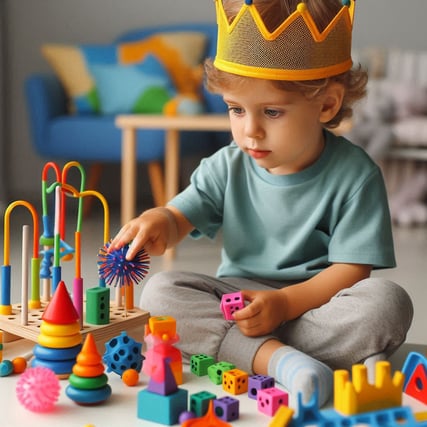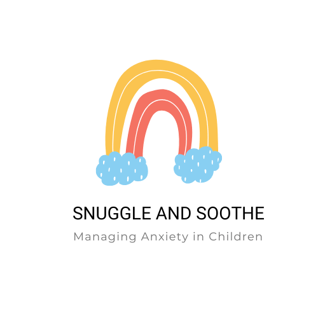The Best Sensory Products and Tips for Managing Anxiety in Children with Autism
Blog post description.
5/25/20253 min read


Helping autistic children manage anxiety starts with creating a safe, sensory-friendly environment that supports their unique needs. Sensory tools can play a huge role in self-regulation, allowing children to feel calm, secure, and in control. In this post, we’ll explore the best sensory products that help ease anxiety, along with practical tips to create a soothing space for your child.
Understanding Sensory Needs and Anxiety
Anxiety in autistic children is often linked to sensory sensitivities, difficulty with transitions, and struggles with social expectations. Many autistic children experience sensory overload when faced with bright lights, loud noises, or unexpected changes. They might react by withdrawing, stimming, or experiencing meltdowns. Sensory tools can help reduce this overwhelm and create a comforting space where they feel safe.
Best Sensory Products for Anxiety Relief
1. Weighted Blankets – A hug for comfort. Weighted blankets provide deep pressure stimulation, which has a calming effect on the nervous system. The gentle weight helps children feel secure and grounded, reducing stress and improving sleep. Choose a blanket that is about 10% of your child’s body weight for the best effect.
2. Fidget Tools – Small movements that create big comfort. Fidget tools like squishy balls, pop-its, and fidget cubes help autistic children release excess energy and stay focused. These tools are great for school, car rides, or moments when a child needs discreet sensory input to self-soothe.
3. Noise-Cancelling Headphones – Blocking out loud environments can be overwhelming for autistic children. Noise-cancelling headphones help reduce auditory overstimulation, making places like classrooms or shopping malls more manageable. Choose headphones with adjustable volume control so your child can find their perfect level of comfort.
4. Sensory Tents or Calm Spaces – A private retreat creating a safe sensory space at home can significantly reduce anxiety. A small tent, a cosy corner, or a nook with sensory pillows and calming lights offers a place for children to retreat when they feel overwhelmed. You can fill it with sensory-friendly tools, books, or soothing textures.
5. Body Socks – Body socks provide deep pressure stimulation and help with body awareness. This snug, stretchy fabric allows children to move freely while feeling comforted by the pressure, which can be helpful for grounding and self-regulation.
6. Sensory Toothbrush - Sensory toothbrushes help autistic children by reducing oral sensitivity, providing gentle stimulation, and making brushing more comfortable. Soft bristles, ergonomic handles, and calming textures encourage better hygiene while minimizing sensory overload.
7. Sensory Lights – Harsh lighting can feel overwhelming, but soft sensory lights create a calming atmosphere. Lava lamps, fibre optic lights, or LED colour-changing lamps regulate mood and provide a peaceful space for unwinding.
8. Visual Timers & Schedules – Predictability eases anxiety and many autistic children thrive on routine. Using visual timers and daily schedules helps them understand transitions and prepare for upcoming activities. This reduces anxiety around the unknown and helps children feel in control of their day.
Tips for Managing Anxiety in Autistic Children
1. Establish a Predictable Routine - Consistency is key to reducing anxiety. Having a structured daily routine helps autistic children feel secure in their environment. Try to keep mealtimes, playtimes, and bedtimes consistent to create stability.
2. Use Sensory Breaks - Encourage sensory breaks throughout the day—whether it’s time in a sensory tent, using a weighted blanket, or simply stepping away from a stressful situation. This helps children reset and self-regulate.
3. Create a Calming Space - A dedicated quiet area at home with comfortable textures, dim lighting, and sensory tools can serve as a safe place for children when they feel overwhelmed.
4. Introduce Social Stories - Social stories help children navigate new experiences with predictability and comfort. If a child is anxious about going to a new place, meeting someone, or trying an activity, creating a story with pictures explaining what will happen can help ease their fears.
5. Encourage Gentle Movement - Exercise can be a great way to manage anxiety! Activities like jumping on a trampoline, swinging, or yoga provide essential sensory input and help regulate emotions.
6. Practice Breathing and Mindfulness - Simple breathing exercises can help ease stress. Teaching children to take deep breaths when feeling overwhelmed can be an effective self-regulation strategy.
7. Support Their Special Interests - Autistic children often have deep passions for specific topics. Encouraging their interests can provide a sense of joy and comfort, helping them self-soothe during anxious moments.
Managing anxiety in autistic children requires a thoughtful approach, with sensory-friendly tools and supportive strategies that help them feel safe and understood. Whether it’s weighted blankets, fidget tools, sensory rooms, or predictable routines, each small step makes a big difference in creating a more soothing, supportive environment.
By incorporating these sensory products and tips, you can help reduce stress and empower autistic children to navigate anxiety with confidence.
